悬架设计计算说明书
悬架设计说明书

前言本小组课程设计的课题是普通的经济型轿车。
因而,其定位为中等收入的工薪阶层的第一辆家庭用车。
必须满足以下几个要求:可靠,坚固,耐用,使用成本较低,油耗处于国内中等水平,为当前主流技术水平。
所以,悬架的设计宜选用成熟技术,零部件,彻底的贯彻“三化”原则,较为合理的成本控制。
悬架是现代汽车的重要组成部分之一。
虽然并非汽车在行进必不可少的装备,但如果没有悬架,将极大的影响汽车的操纵稳定性和平顺性。
悬架对整车性能有着重要的影响。
在汽车市场竞争日益加剧的今天,人们对汽车的性能的认识更多的靠更为直接的感观感受,而非他们不太懂得的专业术语。
因此,对汽车操纵稳定性﹑平顺性的提升成为了各大汽车厂商的共识。
与此关系密切的悬架系统也被不断改进,主动半主动悬架等具有反馈的电控系统在高端车辆上的应用日趋广泛。
无论定位高端市场,还是普通家庭的经济型轿车,没有哪个厂家敢忽视悬架系统及其在整车中的作用。
这一切,都是因为悬架系统对乘员的主观感受密切联系。
悬架系统的优劣,乘员在车上可以马上感受到。
“木桶理论”,很多人都知道,整车就好比是个“大木桶”,悬架是它的一片木板。
虽然,没有悬架的汽车还是可以跑动的,但是坐在上面是很不舒服的。
坐过农用车货厢的人,对此应该是颇有些体会的,即便是较好的路况,在上面也是颠来颠去的。
因为它的悬架很简单,对平顺性和操纵稳定性考虑的很少。
只有当悬架这块木板得到足够重视,才能使整车性能得以提升。
否则,只能是句空话。
这涉及到部件与整体的关系。
一句话:整体离不开部件,部件也成不了整体。
整体可以提供部件提供不了的功能,反过来部件又对整体有着重要影响。
正因为悬架在现代汽车上的重要重要作用,应该重视汽车悬架的设计。
只有认真,严谨的设计才能确保其与整车的完美匹配。
而要做到这一点,就必须,查阅大量相关书籍,图册,行业和国家标准。
这些是对我们这些将来要从事汽车设计,制造工作的工科出身的大学毕业生的必须经历的一个必不可少的训练。
汽车悬架系统设计说明书.2doc
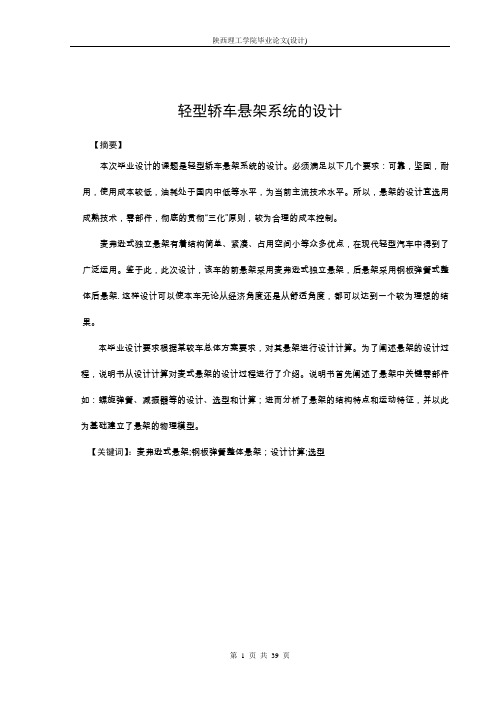
轻型轿车悬架系统的设计【摘要】本次毕业设计的课题是轻型轿车悬架系统的设计。
必须满足以下几个要求:可靠,坚固,耐用,使用成本较低,油耗处于国内中低等水平,为当前主流技术水平。
所以,悬架的设计宜选用成熟技术,零部件,彻底的贯彻“三化”原则,较为合理的成本控制。
麦弗逊式独立悬架有着结构简单、紧凑、占用空间小等众多优点,在现代轻型汽车中得到了广泛运用。
鉴于此,此次设计,该车的前悬架采用麦弗逊式独立悬架,后悬架采用钢板弹簧式整体后悬架.这样设计可以使本车无论从经济角度还是从舒适角度,都可以达到一个较为理想的结果。
本毕业设计要求根据某较车总体方案要求,对其悬架进行设计计算。
为了阐述悬架的设计过程,说明书从设计计算对麦式悬架的设计过程进行了介绍。
说明书首先阐述了悬架中关键零部件如:螺旋弹簧、减振器等的设计、选型和计算;进而分析了悬架的结构特点和运动特征,并以此为基础建立了悬架的物理模型。
【关键词】:麦弗逊式悬架;钢板弹簧整体悬架;设计计算;选型The design of Light passenger vehicle Suspension SystemChen xiang(grade06,class01, Heat Energy and Dynamical Engineering,Shaanxi University of Technology,Hanzhong723000,Shaanxi ,Tutor:shi shao ning)AbstractTime of graduation practice problem is that the light saloon hangs to put up systematic design. As a result, Must satisfy several the following call for: Reliable , sturdy and durable, use cost comparatively low, the low grade is horizontal in oil being consumed being in in the homeland , the technology is horizontal for current main current. The design putting up therefore, hanging ought to select and use the mature technology , component and part , put "three into effect completely spending " principle , comparatively rational cost controls.Maifuxun style has had structure simple , compact independent dangerous rack , has occupied space waiting for a lot of merit for a short time , in modern light automobile to apply broadly. Because of this , this time, going forward designing that , that vehicle hangs to adopt the dyadic independent dangerous Maifuxun rack , rear overhang puts up adopt the dyadic overall of band spring rear overhang rack. Such designs that the angle still is from comfortable angle from economy being able to make this vehicle regardless of , can reach a comparatively ideal result.Graduation practice requires that comparatively, the vehicle overall plan demands , the design being in progress to whose dangerous rack secretly schemes against according to some. For the design setting forth the dangerous rack, process , specifications introduce that from designing that the process calculating the design to dyadic dangerous wheat rack has been in progress. Specifications has set forth dangerous rack middle key component and part first such as: Spiral spring , the design that the shock absorber waits for, choose a type and secretly scheme against; Have analysed the dangerous rack structure characteristic and the physics model moving a characteristic, and being that the basis has built the dangerous rack on this account then.Key words: McPherson suspension;The whole steel spring suspension; design and selection;目录中文摘要 (1)ABSTRACT (2)第一章绪论 (6)1.悬架的功用 (6)2.悬架系统的组成 (7)3.悬架的类型及其特点 (8)3.1非独立悬架的类型及特点 (9)3.2独立悬架的类型及特点 (10)4悬架形式的选择 (13)4.1总评 (13)4.2前后悬架的确定 (14)第二章悬架的设计计算 (14)1.悬架设计要求 (15)2.前悬架的设计计算 (16)2.1弹簧形式的选择 (16)2.2材料的选择 (16)3.弹簧参数的计算 (17)3.1圆柱螺旋弹簧直径d的计算 (17)3.2求有效圈数 (17)3.3其它参数 (18)4.弹簧的校验 (19)5.后悬架的设计计算 (20)5.1弹性元件的选择 (20)5.1.1加工要求 (20)5.2.2材料的参数 (20)6.钢板弹簧参数的设计计算 (21)6.1挠度的确定 (21)6.2各片长度的确定 (22)6.3断面高度及片数的确定 (22)6.4厚度的确定 (23)6.5板簧总成在自由状态下得弧高及其曲率半径 (23)7.钢板弹簧的强度校验 (24)第三章减振器的结构原理及其功用 (25)1.减震器的作用 (26)2.减震器的结构 (27)3.减震器的工作原理 (27)第四章横向稳定器的作用 (28)第五章麦佛逊式悬架导向机构 (30)1独立悬架导向机构 (38)2麦弗逊式悬架系统物理模型的建立 (40)结论 (42)参考文献 (42)致谢 (43)引言此次毕业设计的课题是轻型轿车的悬架系统。
悬架设计计算说明书
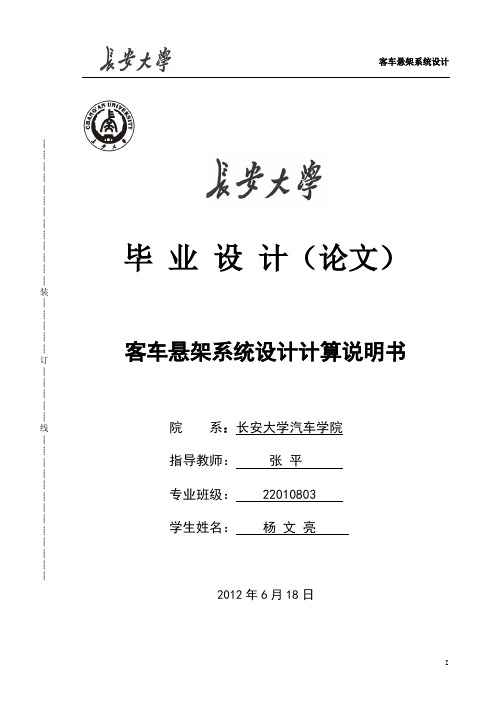
┊┊┊┊┊┊┊┊┊┊┊┊┊装┊┊┊┊┊订┊┊┊┊┊线┊┊┊┊┊┊┊┊┊┊┊┊┊毕业设计(论文)客车悬架系统设计计算说明书院系:长安大学汽车学院指导教师:张平专业班级: 22010803学生姓名:杨文亮2012年6月18日┊┊┊┊┊┊┊┊┊┊┊┊┊装┊┊┊┊┊订┊┊┊┊┊线┊┊┊┊┊┊┊┊┊┊┊┊┊摘要目前我国的客车普遍采用的是传统钢板弹簧悬架,只有少数的高级客车才配置了空气悬架。
传统钢板弹簧的结构简单,成本较低。
而相对于传统机械钢板弹簧悬架而言,空气悬架具有乘坐更舒适、更好改善车辆的行驶平顺性等显著优点,但是造价也相对较高。
本文针对客车的悬架设计,在传统钢板弹簧悬架的基础上对前悬进行改进,前悬采用钢板弹簧与空气弹簧并联的混合式空气悬架,而后悬采用主副复合式钢板弹簧悬架。
前悬的混合式空气悬架能满足驾驶员舒适性的要求,而后悬架的主副复合式钢板弹簧降低了整车的生产成本。
对前、后悬架的主要零部件的尺寸进行设计计算,并运用CATIA进行建模和装配。
关键词混合式空气悬架,CATIA,主副复合式钢板弹簧悬架┊┊┊┊┊┊┊┊┊┊┊┊┊装┊┊┊┊┊订┊┊┊┊┊线┊┊┊┊┊┊┊┊┊┊┊┊┊ABSTRACTAt present, buses generally use the traditional leaf spring suspension in our country , only a handful of senior buses was equipped with air suspension. Traditional leaf spring structure is simple and with low cost . In contrastto traditional mechanical leaf spring suspension, the air suspension has more significant advantages, such as , more comfortable to ride, better improvement of the vehicle ride comfort. However , the cost is relatively high.This paper is about the bus suspension design .to improve the front suspension on the basis of the traditional leaf spring suspension , front suspension uses hybrid air suspension combined parallel with leaf springs andair springs , and then rear suspension uses primary and secondary compound leaf spring suspension. the front air suspension can meet the requirementsof driver comfort , but leaf spring in the rear suspension can reduce the manufacturing cost.Design and calculate the size parameters of the main components in the front and rear suspension, and modeling and assembly in use of CATIA.KEYWORDS: hybrid air suspension ,catia ,primary and secondary compound leafspring suspension┊┊┊┊┊┊┊┊┊┊┊┊┊装┊┊┊┊┊订┊┊┊┊┊线┊┊┊┊┊┊┊┊┊┊┊┊┊目录摘要 (II)ABSTRACT ......................................................................................................................... I II 第一章绪论 .. (1)1.1本课题研究的背景与意义 (1)1.2空气悬架技术发展概况 (2)1.2.1空气悬架发展历史 (2)1.2.2国外应用及技术研究状况 (3)1.2.3国内应用及技术研究状况 (4)1.3本课题研究的目的和内容 (5)目的: (5)内容: (5)第二章悬架概述及客车悬架方案的选定 (7)2.1 客车悬架的要求 (7)2.2方案确定 (7)2.3 空气悬架系统的特性 (8)2.4 悬架的分析 (8)2.5 混合式空气悬架 (9)2.6前悬架混合式空气弹簧设计 (11)2.6.1 设计依据 (11)2.6.2设计原则 (11)2.7 空气弹簧的结构 (11)2.8空气弹簧理论特性分析 (13)2.8.1空气弹簧的弹性特性 (13)2.8.2空气弹簧的负荷特性 (15)2.9 辅助机构设计 (17)2.9.1横向稳定装置 (17)2.9.2 横向稳定杆侧倾角刚度 (17)2.9.3横向稳定杆直径d (17)2.9.4缓冲块 (18)第三章后悬架复合式钢板弹簧设计 (19)3.1 钢板弹簧的布置方案 (19)┊┊┊┊┊┊┊┊┊┊┊┊┊装┊┊┊┊┊订┊┊┊┊┊线┊┊┊┊┊┊┊┊┊┊┊┊┊3.2 主副复合式钢板弹簧 (19)3.3设计依据 (19)3.4后悬架主、副弹簧刚度分配 (20)3.5钢板弹簧的静挠度 (20)3.6钢板弹簧的满载弧高 (21)3.7 钢板弹簧的断面形状 (21)3.8钢板弹簧主片长度的确定 (22)3.9钢板弹簧片厚的计算 (22)3.10 钢板弹簧片宽的计算 (23)3.11 钢板弹簧片数的计算 (24)3.12 钢板弹簧各片长度的计算 (24)3.13钢板弹簧刚度的计算 (25)3.14钢板弹簧总成在自由状态下的弧高及曲率半径的计算 (26)3.15 钢板弹簧的强度验算 (28)第四章减振器设计 (30)4.1相对阻尼系数ψ (30)4.2减振器阻尼系数δ的确定 (31)4.3最大卸荷力的确定 (31)4.4筒式减振器工作缸直径D的确定 (31)结论 (32)致谢 (33)参考文献 (34)┊┊┊┊┊┊┊┊┊┊┊┊┊装┊┊┊┊┊订┊┊┊┊┊线┊┊┊┊┊┊┊┊┊┊┊┊┊第一章绪论1.1本课题研究的背景与意义悬架是现代汽车上的重要组成之一,它把车架(或车身)与车轴(或车轮)弹性地连接起来。
悬架系统设计计算说明书
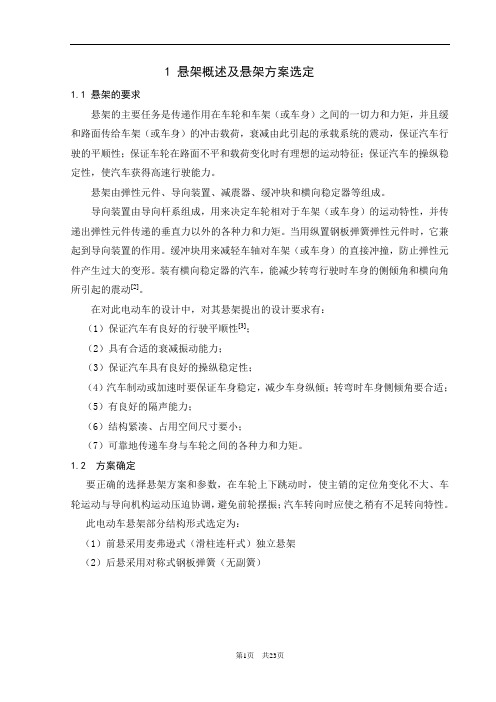
1 悬架概述及悬架方案选定1.1 悬架的要求悬架的主要任务是传递作用在车轮和车架(或车身)之间的一切力和力矩,并且缓和路面传给车架(或车身)的冲击载荷,衰减由此引起的承载系统的震动,保证汽车行驶的平顺性;保证车轮在路面不平和载荷变化时有理想的运动特征;保证汽车的操纵稳定性,使汽车获得高速行驶能力。
悬架由弹性元件、导向装置、减震器、缓冲块和横向稳定器等组成。
导向装置由导向杆系组成,用来决定车轮相对于车架(或车身)的运动特性,并传递出弹性元件传递的垂直力以外的各种力和力矩。
当用纵置钢板弹簧弹性元件时,它兼起到导向装置的作用。
缓冲块用来减轻车轴对车架(或车身)的直接冲撞,防止弹性元件产生过大的变形。
装有横向稳定器的汽车,能减少转弯行驶时车身的侧倾角和横向角所引起的震动[2]。
在对此电动车的设计中,对其悬架提出的设计要求有:(1)保证汽车有良好的行驶平顺性[3];(2)具有合适的衰减振动能力;(3)保证汽车具有良好的操纵稳定性;(4)汽车制动或加速时要保证车身稳定,减少车身纵倾;转弯时车身侧倾角要合适;(5)有良好的隔声能力;(6)结构紧凑、占用空间尺寸要小;(7)可靠地传递车身与车轮之间的各种力和力矩。
1.2 方案确定要正确的选择悬架方案和参数,在车轮上下跳动时,使主销的定位角变化不大、车轮运动与导向机构运动压迫协调,避免前轮摆振;汽车转向时应使之稍有不足转向特性。
此电动车悬架部分结构形式选定为:(1)前悬采用麦弗逊式(滑柱连杆式)独立悬架(2)后悬采用对称式钢板弹簧(无副簧)2 悬架结构形式分析2.1 悬架的分析悬架可分为非独立悬架和独立悬架两类。
非独立悬架的结构特点是左右车轮用一跟整体轴连接,再经过悬架与车身(或车身)连接,如图3.1(a)所示;独立悬架的结构特点是左右车轮通过各自的悬架与车架(或车身)连接,如图3.1(b)所示[4]。
以纵置钢板弹簧为弹性元件兼做导向装置的非独立悬架,其主要优点是结构简单,制造容易,维修方便,工作可靠。
汽车独立悬架设计说明书(毕业设计)

独立悬架设计说明书摘要本设计主要讲述了悬架的定义和重要性,描述了悬架的作用和功能主要阐述了独立悬架的类别和构造尤其是详细的介绍了麦弗逊式独立悬架的设计过程,本着满足车辆行使平顺性的原则,设计了麦弗逊式独立悬架的各个组成部件,并对其进行了校核。
如螺旋弹簧的设计和计算,横向稳定杆的设计,对导向机构进行了平顺性分析,横摆臂的长度计算和减震器的设计计算等。
轿车悬架是一个较难达到完美要求的汽车总成,这是因为悬架既要满足汽车的舒适性要求,又要满足其操纵稳定性的要求,而这两方面又是互相对立的。
比如,为了取得良好的舒适性,需要大大缓冲汽车的震动,这样弹簧就要设计得软些,但弹簧软了却容易使汽车发生刹车“点头”、加速“抬头”以及左右侧倾严重的不良倾向,不利于汽车的转向,容易导致汽车操纵不稳定等。
怎样处理好这些方面的关系就摆在了我们设计人员的面前。
因此要是能够设计出使这些方面都能达到一个和谐的悬架对越来越多的汽车使用人员来说将会带来极大的好处。
他们将会体会到优秀悬架带给他们的良好的舒适性,和安全的平顺性。
希望本人的设计能够满足大家的要求。
本设计的图纸主要由计算机绘制完成,计算机编档、排版,打印出图及论文。
还完成了一定量的英文翻译工作。
关键词:麦弗逊式独立悬架悬架汽车悬架AbstractThe main design on the suspension of the definition and importance of a suspension described the role and functions primarily on the type of independent suspension and tectonic particularly detailed introduced Maifuxun independent suspension design process, in the spirit of the exercise smoothly vehicles meet the principles of the design of the independent suspension Maifuxun various components, and the degree of their. If screw spring-loaded design and calculation, horizontal designed to guide agencies conducted smoothly and analytical, Wang squatting length calculation and shock absorber design.Training is a perfect car for the car more difficult to achieve fuel, because it is necessary to meet the suspension of vehicle comfort, but also meet the requirements of the stability of its manipulation, and these two aspects are mutually antagonistic. For example, in order to achieve good sexual comfort, require a significant buffer car shock, which is designed spring-loaded soft farther, but the spring-loaded soft but easy to vehicle braking occurred "nod" and accelerate the "rise" and so serious adverse trends, to the detriment of the vehicle to easily lead to vehicle instability manipulation. How to handle the relationship between these areas before our designers have to face the problem .So if these meet the mission to design a harmonious suspension of a growing number of vehicles involved will bring great benefits. They will understand theiroutstanding suspension to the comfort of a good, and safe smoothly. I hope the design can satisfy all requirements.The design drawings completed mainly by computer mapping, computer archiving, typesetting, printing out maps and papers. Also completed a number of English translation work.Keyword:Maifusun type of independent suspension suspension Motor Training1概述1.1 悬架的定义及其重要性悬架是保证车轮与汽车承载之间具有弹性联系并能传递载荷、缓和冲击、衰减振动以及调节汽车行驶中的车身位置等有关装置的综总称。
悬架系统设计计算书

3、后悬架静挠度的计算
前悬架垂向变形量(mm)
2、弹簧刚度计算 2.1、前悬架弹簧刚度计算
空载 56.15497608
半载 85.68500616
b 255.7 弹簧与下摆臂垂线的夹角(空间)a 、 rad 弹簧的刚度 N/mm
考虑在悬架系统中衬套的刚度约为悬架刚 度的15%~30%;共有衬套2个; 这里取 值为15%
后轴荷(kg)
半载
满载
单侧前悬架非簧载质量(kg)
单侧后悬架非簧载质量(kg)
前悬侧倾心高 mm
后悬侧倾心高 mm
参数值 475 460 452
819.15
857.96
950.34
900 900 1905 200 300 114 147.2928 150.33 86 120.7072 149.67
9 10 10.69 57.45
G ——弹簧材料的剪切弹性模量,这里
由于弹簧的材料为合金弹簧钢丝,所以, 取为80000 MPa;
G
i ——弹簧工作圈数,初取6.0圈;
Dm ——弹簧中径,初取130mm; d ——弹簧钢丝直径,mm。
d 由公式(5)可以得的计算公式如下 d 4 i • 8 • Dm3 • Cs G
G i Dm d 弹簧钢丝直径为:d
K m * ( H
3.2 前后悬架侧倾角刚度
1 前悬架螺旋弹簧作用的侧倾角 刚度
K s
1 2
C
s
(B p
lb n
cos )2
弹簧中心线与下控制臂的垂线的夹角 a 参数
前悬架的侧倾角刚度 K sf
N.mm/rad
考虑衬套扭转时的刚度有约为15%~20% 的影响;
deg 13.2
悬架系统设计计算书

前悬架 0.17
0.43
0.3
后悬架 0.2
0.4
0.3
2 减振器阻尼系数δ的确定
减振器的阻尼系数δ为:
式中: C——为悬架刚度(N/mm);
m——满载簧载质量(kg)。 ω——为悬架固有(圆)频率
(rad/s);
2 c m 2m
在悬架中减振器轴线与垂直线成一定的夹 角α时,如下图,减振器阻尼系数为
弹簧钢丝直径为:d
8.0mm
3、侧倾计算
3.1、整车侧倾角刚度
侧倾刚度是指在侧倾角不大的饿情况下,车身倾斜单位角度所必需的力矩,根据汽车工程手册P79 加速度为0.5g时,车身的侧向角为2.5o来计算悬架的刚度。整车的侧倾示意图如下:
如上图所示,簧上质量质心所在横向平面内的侧倾轴到地面的高度为h,前后悬架的侧倾角刚度分 心高度为h1 后悬架的侧倾中心高度为h2,簧上质量为m,,侧向加速度为μ,质心到前后轴的距离为L
c/m
2m i2 cos2
式中: i——杠杆比;i=n/a ——减振器安装角; ω——为悬架固有(圆)频率;
m——满载单侧簧载质量(kg)
根据前后悬架减振器的布置形式简化为双 横臂的形式,以下各参数取值如下:
M(kg/满载单侧)
悬架刚度(N/mm)
n (次/分) i
()
a(rad)
悬架固有(圆)频率ω
h
h1
L1
L1 L2
(h2
h1 )
簧上质量质心所在横向平面内的侧倾轴到 地面的高度 h mm
h1 10.69
31.74942761
h2 57.45
绕侧倾轴的力矩平衡为
m (H h) cos G (H h) sin (Kf Kr )
麦弗逊悬架设计说明书

目录摘要 (2)ABASTRACT (3)第一章前言 (4)第二章设计任务 (5)第三章悬架的结构分析及选型 (6)3.1悬架的分类 (6)3.2非独立悬架与独立悬架优缺点分析 (6)3.3独立悬架结构形式分类及分析 (7)第四章方案论证 (8)4.1 悬架结构方案分析 (8)4.2弹性元件 (9)4.3减震元件 (10)4.4传力构件及导向机构 (10)4.5横向稳定器 (11)第五章前悬架系统的主要参数的确定及对整车性能的影响 (11)5.1悬架的静扰度 (11)5.2悬架的动扰度 (12)5.3悬架的弹性特性 (12)5.4前悬架主销侧倾角与后倾角 (13)第六章弹性元件的计算 (14)6.1 螺旋弹簧的设计 (14)第七章减震器机构的类型及主要参数的选择计算 (15)7.1减震器分类 (15)7.2相对阻尼系数 (15)7.3减震器阻尼系数的确定 (14)7.4最大卸荷力的确定 (17)7.5减震器工作缸直径的确定 (18)结论 (19)参考文献 (20)摘要为了提高汽车行驶的平顺性和稳定性, 本课题进行了产品名称为QF1020货车前后悬架的设计。
通过对课题内容的分析, 并结合相关设计手册,进行了方案设计与比较, 设计了麦弗逊前悬架, 钢板弹簧后悬架。
在设计中,首先,分析了麦弗逊独立悬架的组成和功用;其次,进行悬架的上各零部件强度的校核;第三,详细考虑各部件之间的连接关系;最后在此基础上进行悬架自然振动频率,悬架静挠度和动挠度以及悬架弹性特性的计算。
在分析麦弗逊悬架的组成和作用以及各零部件的尺寸确定的基础上,再利用CAD软件进行二维制图。
此次的设计进行了准确的计算和详细的结构分析,为麦弗逊悬架的结构优化提供了依据,从而在运动学和动力学方面提高汽车的性能。
关键词:麦弗逊悬架;汽车;设计;ABSTRACTIn order to enhance the automobile smooth running and the stability, This topic has carried on the suspension design of the Product Name of QF1020 vehicle. Through analyzing the topic content, and combine the correlation design handbook, carried on the plan to design and to compare, the McPherson strut front suspension , the leaf spring behind suspension and trapezium’s frame are designed. This thesis first analyzes the consists and function of the McPherson suspension in the design, then check the up and down of the suspension, Third, the various components of the link between relations is considered the suspension on the basis of the natural vibration frequency is calculated as well as static suspension deflection and dynamic deflection and elastic characteristics of the suspension terms at last. On the basis of Analysis of the composition and role of the size of the components in the two suspension, then to use CAD software, 2D software mapping .We make an accurate and detailed structural analysis on the design, which provides the reference for optimal design of the suspension. The approach can enhance the performance of the McPherson suspension and leaf spring behind suspension.Keyword: McPherson suspension; Motor vehicle; Design;第一章前言悬架是保证车轮或车桥与汽车承载系统(车架或承载式车身)之间具有弹性联系并能传递载荷、缓和冲击、衰减振动以及调节汽车行驶中的车身位置等有关装置的总称。
悬架设计说明书(模版)

第一章绪论1-1 设计题目及要求一、设计题目及要求丹东黄海牌DD680K01客车空气弹簧后悬架设计1、将原客车钢板弹簧后悬架改为空气悬架;2、对原客车有系统的了解;3、掌握空气悬架的设计方法;4、掌握悬架结构强度的计算方法;5、了解悬架系统对整车性能的影响二、课题内容及工作量1、收集并阅读有关空气悬架设计和研究方面的资料,并进行结构分析,写出综述报告;2、进行空气悬架结构方案验证、结构设计及有关参数设计和选择;3、进行设计中的有关强度及性能的计算分析;4、绘制总成及零部件图4A0;5、编制设计说明书一份,字数约2万字;6、翻译相关方面的资料,合计约为5000字。
三、简要技术参数外形尺寸车长/底盘长8540/8192mm车宽/底盘高2420/2306 mm车高/底盘高3200/1735 mm轴距4100 mm轮距(前/后)1900/1800 mm通过性参数接近角/离去角(整车/底盘)11/10(13/10)后悬/前悬(整车/底盘)1790/2650(1550/2542)mm最小离地间隙≥228mm最小转弯直径≤24 mm质量参数最大总质量(整车/底盘)10300kg最大总质量条件下轴载质量前轴3300kg后桥7000kg变速器型号韶关SG135型速比Ⅰ:6.602; Ⅱ:3.473; Ⅲ:2.130;Ⅳ:1.297; Ⅴ:1.000; R:6.0705后桥主减速器形式双曲面齿轮,单级减速桥壳形式冲压焊接,整体式半轴形式全浮式主减速比 4.33:1悬架空气弹簧配横向稳定杆加双向作用筒式减振器车架形式前后端为槽形梁,中段为桁架式轮胎规格8.25R(K级)轮辋规格7.0-20气压前轮胎5.6Mpa后轮胎6.7Mpa动力性能最高车速≥105km/h直接挡最低稳定车速≤25km/h最大爬坡度≤20%加速性能直接挡从25km/h加速到90km/h用时≤80s原地起步换挡加速到100km/h的时间≤70s经济性能多工况100km体积油耗≤18L环保性能排放CO ≤4.5 g/(kWh) HC ≤1.1 g/(kWh)NO ≤8.0 g/(kWh) PT ≤0.36 g/(kWh)噪声加速行驶车外噪声≤82Db(A)50km/h匀速行驶车内噪声≤78 Db(A)驾驶员耳旁噪声≤80 Db(A)空气弹簧的发展、现状及其概述一、汽车空气悬架发展历史在汽车上采用空气弹簧悬架在我国还是一件比较新的事物,但却不是一种新概念。
计算说明书_悬架系统
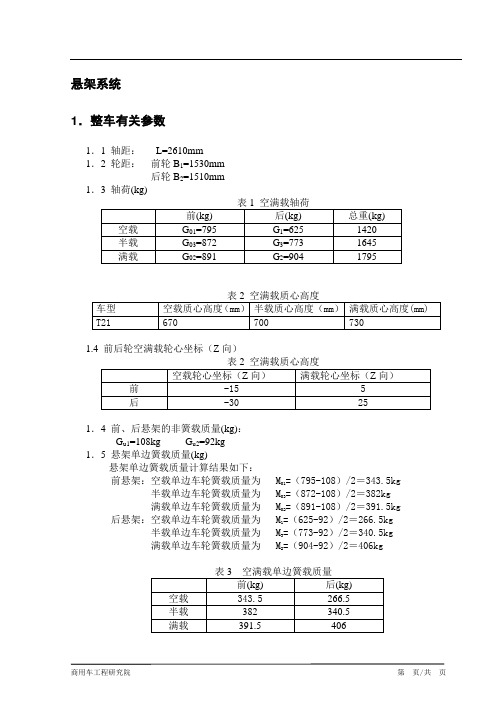
悬架系统1.整车有关参数1.1 轴距:L=2610mm1.2 轮距:前轮B1=1530mm后轮B2=1510mm1.3 轴荷(kg)1.4 前后轮空满载轮心坐标(Z向)1.4 前、后悬架的非簧载质量(kg):G u1=108kg G u2=92kg1.5 悬架单边簧载质量(kg)悬架单边簧载质量计算结果如下:前悬架:空载单边车轮簧载质量为M01=(795-108)/2=343.5kg 半载单边车轮簧载质量为 M03=(872-108)/2=382kg满载单边车轮簧载质量为M02=(891-108)/2=391.5kg 后悬架:空载单边车轮簧载质量为M1=(625-92)/2=266.5kg半载单边车轮簧载质量为M3=(773-92)/2=340.5kg满载单边车轮簧载质量为M2=(904-92)/2=406kg2、前悬架布置前悬架布置图见图1图1 T21前悬架布置简图3、前悬架设计计算3.1 前悬架定位参数:3.2 前悬架采用麦弗逊式独立悬架,带稳定杆,单横臂,螺旋弹簧,双向双作用筒式减震器。
(1) 空满载时缓冲块的位置和受力情况 空载时,缓冲块起作用,不受力 满载时,缓冲块压缩量为13.8mm ,(由DMU 模拟得知,DMU 数据引自T21 M2数据)。
根据缓冲块的特性曲线,当缓冲块压缩13.8mm 时,所受的力为:125N (2) 悬架刚度计算螺旋弹簧行程杠杆比:1.06悬架刚度为K 1= ((391.5-343.5)*9.8-125/1.06)/(5-(-15))= 17.62N/mm(3)前螺旋弹簧①截锥螺旋弹簧②螺旋弹簧行程杠杆比:1.06③刚度C1=K1*(1.06)2*0.9=17.62*(1.06)2*0.9=17.81N/mm(4)静挠度和空满载偏频计算空载时挠度 f 1= N 1/K 1=( M 01*9.8)/K 1=(343.5*9.8)/17.81=18.9cm静挠度 f 01= f 1 +(5-(-15))/10=20.9 偏频n: 空载为 Hz f n 15.19.18/5/511=== 满载为 Hz f n 09.19.20/5/50101===结论:前悬架偏频在1.00~1.45Hz 之间,满足设计要求。
独立悬架设计手册
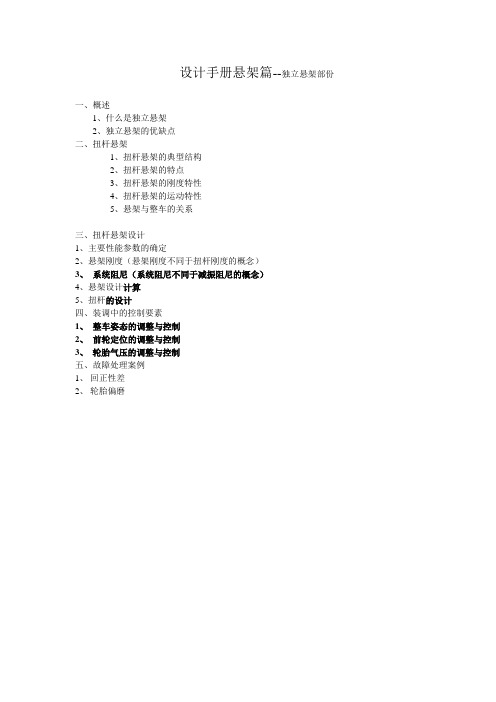
设计手册悬架篇--独立悬架部份一、概述1、什么是独立悬架2、独立悬架的优缺点二、扭杆悬架1、扭杆悬架的典型结构2、扭杆悬架的特点3、扭杆悬架的刚度特性4、扭杆悬架的运动特性5、悬架与整车的关系三、扭杆悬架设计1、主要性能参数的确定2、悬架刚度(悬架刚度不同于扭杆刚度的概念)3、系统阻尼(系统阻尼不同于减振阻尼的概念)4、悬架设计计算5、扭杆的设计四、装调中的控制要素1、整车姿态的调整与控制2、前轮定位的调整与控制3、轮胎气压的调整与控制五、故障处理案例1、回正性差2、轮胎偏磨第一章概述独立悬架是相对于非独立悬架而言的,其特点是左、右两车轮之间各自“独立”地与车架或车身相联,构成断开式车桥,当单边车轮驶过凸起时,不会影响到另一侧车轮。
独立悬架由于其导向机构措综复杂,结构型式很多,但主流结构主要有:双横臂式,纵臂式,麦弗逊式、多连杆式等。
双横臂式独立悬架又细分为等长双横臂式和不等长双横臂式。
一般用于轿车的前、后悬架,轻型载货汽车的前悬架或要求高通过性的越野车的前、后悬架。
纵臂式独立悬架以平行于汽车行驶方向的纵臂承担导向和传力作用,常用于非驱动桥的后悬架。
麦弗逊式,其突出特点在于将导向机构与减振装置合到一起,将多个元零件集成在一个单元内。
不公简化了结构,减轻了质量,还节省了空间,较多应用于紧凑型轿车的前悬架。
与非独立悬架相比,独立悬架的诸多优点:1、非悬挂质量小,悬架所受到并传给车身的冲击载荷小,有利于提高汽车的行驶平顺性及轮胎接地性能;2、左右车轮的跳动没有直接的相互影响,可减少车身的倾斜和振动;3、占用横向空间小,便于发动机布置可以降低发动机的安装位置,从而降低汽车质心位置,有利于提高汽车行驶稳定性;4、易于实现驱动轮转向。
我公司目前所采用的前独立悬架均为不等长双横臂式扭杆悬架,如BJ1027A皮卡车型、BJ1032小卡车型和BJ6486轻客车型等。
第二章扭杆悬架扭杆式双横臂独立悬架,用扭杆作为弹性元件,简称为扭杆悬架。
悬架系统设计计算报告

悬架系统设计计算报告悬架系统设计计算报告⽬录1 系统概述 (1)1.1 系统设计说明 (1)1.2 系统结构及组成 (1)1.3 系统设计原理及规范 (2)2 悬架系统设计的输⼊条件 (2)3 系统计算及验证 (3)3.1 前悬架位移与受⼒情况分析 (3)3.2 后悬架位移与受⼒情况分析 (7)3.3 悬架静挠度的计算 (10)3.4 侧倾⾓刚度计算 (10)3.5 侧倾⾓刚度校核 (13)3.6 侧翻阀值校核 (15)3.7 纵向稳定性校核 (15)3.8 减震器参数的确定 (16)4 总结 (18)参考⽂献 (20)1系统概述1.1系统设计说明悬架是汽车上重要总成之⼀,它传递汽车的⼒和⼒矩、缓和冲击、衰减振动,确保汽车必要的⾏驶平顺性和操纵稳定性。
根据项⽬要求,需要对前后悬架的特征参数进⾏计算与较核,在确保悬架系统满⾜必要功能的同时,使悬架的各特征参数匹配合理,且校核其满⾜通⽤汽车的取值范围。
1.2系统结构及组成该款车型前悬架采⽤麦弗逊式独⽴悬架,该悬架上端螺旋弹簧直接作⽤于前减振器筒体之上,与前减振器共同组成前⽀柱总成,⼀起传递汽车所受⼒和⼒矩,并衰减汽车的振动。
下部三⾓形的摆臂通过橡胶衬套对称安装于副车架的两侧,通过副车架与车⾝牢固的连接在⼀起。
前⽀柱与摆臂总成特定的匹配关系确保了整个悬架系统固有的使⽤特性,使其满⾜实际设计的各项要求,其结构简图如图1所⽰。
图1 前悬架结构形式后悬架采⽤复合纵臂式半独⽴悬架,为经济型车型应⽤最为普遍的⼀种悬架结构,其显著特点是结构简单,成本低,使⽤可靠,侧倾性能优良。
中间⼯字形的扭转梁在传递汽车所受纵向⼒的同时,也为后螺旋弹簧与减振器提供了必要的安装空间,同时通过⾃⾝的扭转刚度保证了后悬架具有优良的侧倾特性。
扭转梁前安装点通过各向异性的橡胶衬套弹性的与车⾝相连,既具有良好的隔振性能⼜防⽌了汽车由于前后轴转向⽽产⽣的过多转向特性。
其结构简图如图2所⽰。
图2 后悬架结构形式1.3系统设计原理及规范LF7133前后悬架的设计是以标杆车为依托,根据标杆车悬架系统基本参数的检测,通过计算,求得反映其悬架系统性能的基本特征量,在保持整车姿态与标杆车⼀致的前提下,依据标杆车的悬架特征量对LF7133车型悬架参数进⾏设计。
6127悬架系统计算书

编号:XML6127客车悬架系统设计计算说明书编制:蒲延良校对:龚子波审核:张焱批准:张焱厦门金龙旅行车有限公司二00五年一月一、设计原则1、保证客车有良好的行驶平顺性,在所有载荷范围内其固有频率尽可能不变,并且能使车身的振动迅速衰减。
2、保证客车有良好的行驶稳定性,悬架导向机构应使客车具有某种程度的不足转向性,在制动时应有抗“点头”作用和在加速时应有抗“仰头”作用。
3、保证有一定的使用寿命,重量轻,安全可靠。
充分利用本公司现有车型的总成及零部件,提高产品的“三化”水平,减少生产准备工作量。
二、整车有关参数根据车型总布置方案,提供下列数据作为本悬架设计的依据:轴距 ······································· L =6000mm 前轴轮距 ································ B 1=2080mm 后轴轮距 ································ B 2=1860mm 满载时整车重心高度 ············· h g =1300mm 轴荷(N )前轴轴荷 后轴轴荷 空载 43000 88000 满载57800110000参考类似车型估算:前悬架非簧载质量G u1=550kg ;后悬架非簧载质量G u2=1200kg 。
轿车悬架系统设计说明书

摘要随着汽车工业技术的发展,人们对汽车的行驶平顺性,操纵稳定性以及乘坐舒适性和安全性的要求越来越高。
汽车行驶平顺性反映了人们的乘坐舒适性,而舒适性则与悬架密切相关。
因此,悬架系统的开发与设计具有很大的实际意义。
本次设计主要研究的是比亚迪F3轿车的前、后悬架系统的硬件选择设计,计算出悬架的刚度、静挠度和动挠度及选择出弹簧的各部分尺寸,并且通过阻尼系数和最大卸荷力确定了减振器的主要尺寸,最后进行了横向稳定杆的设计以及汽车平顺性能的分析。
本设计在轿车前后悬架的选型中均采用独立悬架。
其中前悬架采用当前家庭轿车前悬流行的麦弗逊悬架。
前、后悬架的减振器均采用双向作用式筒式减,后悬则采用半拖曳臂式独立悬架振器。
这种结构的设计,有效的提高了乘座的舒适性和驾驶稳定性。
采用CAXA软件分别绘制前后悬架的装配图和部分主要零件图。
关键词:悬架;平顺性;弹性元件;阻尼器;AbstractWith the development of the automobile industry of motor vehicles on ride comfort, handling and stability as well as comfort and safety of the increasingly demanding, Vehicle Ride also closely related with the suspension. Therefore, the design of the suspension system has a practical significance.The main design of the study is BYD F3 car front and rear the suspension system of choice of hardware design, calculate the suspension stiffness, static and dynamic deflection deflection. By damping and unloading of the largest absorber identified the main dimensions. Finally, the design of the horizontal stabilizer. The design of the car before and after the suspension are used in the selection of independent suspension. Suspension of them adopted before the current family sedan before hanging popular McPherson suspension, was suspended after a drag arm suspension. Before and after the suspension of the shock absorber have adopted a two-way role-Shock Absorber. The design of this structure, effectively raising theof comfort and driving stability. By CAXA software were drawn before and after the suspension of the assembly and parts plans.Key words: suspension; ride comfort; elastic element;buffer;目录摘要 (I)Abstract (II)目录 (III)第1章绪论 (1)1.1悬架系统概述 (1)1.2悬架的构成和类型 (3)1.2.1构成 (3)1.2.2类型 (3)1.3课题研究的目的及意义 (4)第2章前、后悬架结构的选择 (5)2.1悬架的结构形式 (5)2.2非独立悬架 (5)2.3独立悬架 (6)2.4 前后悬架方案的选择 (7)2.5主要元件 (8)2.5.1弹性元件 (8)2.5.2减振器 (9)2.6辅助元件 (9)2.6.1横向稳定器 (9)2.6.2缓冲块 (10)第3章技术参数确定与计算 (11)3.1悬架性能参数的选择 (11)3.2悬架的自振频率 (11)3.3侧倾角刚度 (12)3.4悬架的动、静挠度选择 (12)第4章弹性元件的设计计算 (14)4.1前悬架弹簧 (14)4.2后悬架弹簧 (15)第5章悬架导向机构的设计 (17)5.1导向机构设计要求 (17)5.2麦弗逊独立悬架示意图 (17)5.3导向机构受力分析 (18)5.4横臂轴线布置方式 (20)5.5导向机构的布置参数 (20)5.5.1 侧倾中心 (20)第6章减振器设计 (22)6.1减振器的概述 (22)6.2减振器的分类 (22)6.3减振器参数选取 (23)6.4减振器阻尼系数 (23)6.5最大卸荷力 (24)6.6筒式减振器主要尺寸 (24)6.6.1筒式减振器工作直径 (24)6.6.2油筒直径 (25)第7章横向稳定杆的设计 (26)第8章平顺性分析 (27)8.1平顺性概念 (27)8.2汽车的等效振动分析 (27)8.3车身加速度的幅频特性 (28)8.4相对动载的幅频特性 (29)8.5悬架动挠度的幅频特性 (31)8.5影响平顺性的因数 (32)8.5.1结构参数对平顺性的影响 (32)8.5.2使用因素对平顺性的影响 (33)第9章总结 (34)参考文献 (35)致谢 (36)附录Ⅰ (37)Suspension Principle Of Work (37)附录Ⅱ (48)第1章绪论1.1悬架系统概述自十九世纪末期出现第一辆汽车以来,汽车工业经历了一百多年的发展过程。
汽车悬架设计说明书
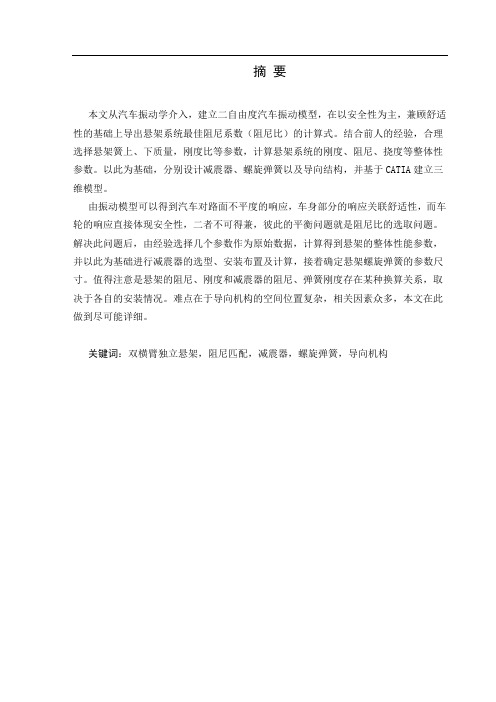
本文从汽车振动学介入,建立二自由度汽车振动模型,在以安全性为主,兼顾舒适性的基础上导出悬架系统最佳阻尼系数(阻尼比)的计算式。
结合前人的经验,合理选择悬架簧上、下质量,刚度比等参数,计算悬架系统的刚度、阻尼、挠度等整体性参数。
以此为基础,分别设计减震器、螺旋弹簧以及导向结构,并基于CATIA建立三维模型。
由振动模型可以得到汽车对路面不平度的响应,车身部分的响应关联舒适性,而车轮的响应直接体现安全性,二者不可得兼,彼此的平衡问题就是阻尼比的选取问题。
解决此问题后,由经验选择几个参数作为原始数据,计算得到悬架的整体性能参数,并以此为基础进行减震器的选型、安装布置及计算,接着确定悬架螺旋弹簧的参数尺寸。
值得注意是悬架的阻尼、刚度和减震器的阻尼、弹簧刚度存在某种换算关系,取决于各自的安装情况。
难点在于导向机构的空间位置复杂,相关因素众多,本文在此做到尽可能详细。
关键词:双横臂独立悬架,阻尼匹配,减震器,螺旋弹簧,导向机构This paper from the automobile vibration intervention, the establishment of two degree of freedom vehicle vibration model, in order to safety, balance the basic comfort on the optimal damping coefficient derived suspension system (damping) formula. Combined with previous experience, reasonable selection of suspension spring, mass, stiffness ratio; stiffness, damping, deflection whole parameter calculation of suspension system. On this basis, designed shock absorber, helical spring and guide structure.A three-dimensional model based on CATIAGet the response of automobile unevenness of pavement by the vibration model, the response relationship of body part comfort, while the wheels directly reflect the response of the security, the two can not have both, balance each other's damping ratio selection problem. To solve this problem, the experience of several parameters as the original data, calculate the performance parameters of the suspension, selection, and use it as the basis for shock absorber mounting arrangement and calculation of parameters; and then determine the size of suspension coil spring. It is interesting to note that the suspension damping, stiffness and shock absorber damping, spring stiffness has a conversion relation, depending on the installation of their. The difficulty lies in the spatial position of steering mechanism is complex, many relevant factors, this paper do as much detail as possible.Keywords: double wishbone suspension, damping matching, shock absorber, helical spring, the guide mechanism of suspension悬架系统是汽车的重要总成之一。
空气悬架设计计算说明书

大客车前空气悬架设计计算说明书毕业设计(论文)开题报告完成;2.设计的目的及意义至少800字,基本内容和技术方案至少400字;3.指导教师意见应从选题的理论或实际价值出发,阐述学生利用的知识、原理、建立的模型正确与否、学生的论证充分否、学生能否完成课题,达到预期的目标。
郑重声明本人郑重声明:所呈交的论文是本人在导师的指导下独立进行研究所取得的研究成果。
除了文中特别加以标注引用的内容外,本论文不包括任何其他个人或集体已经发表或撰写的成果作品。
本人完全意识到本声明的法律后果由本人承担。
本人签名:日期:目录摘要 (1)Abstract (2)1绪论 (3)1.1悬架的概述 (3)1.2悬架的分类 (4)1.3悬架技术的研究现状及发展趋势 (5)2空气悬架结构 (7)2.1空气悬架结构简介 (7)2.2 空气悬架系统的工作原理8 ··························3 空气悬架系统结构方案设计 (10)3.1空气弹簧悬架与机械弹簧悬架比较 (10)3.2空气弹簧的种类及布置问题 (10)3.3高度控制阀 (11)3.4反弹限位 (13)3.5减振器 (13)3.6导向机构的选择及布置............................................................... . (14)4 悬架主要参数的确定 (16)4.1 大客车的结构参数 (16)4.2 悬架静挠度 (18)4.3 悬架动挠度 (18)4.4 悬架弹性特性 (19)5 弹性元件的设计 (20)5.1 空气弹簧力学性能 (21)5.2 高度控制阀 (22)6 悬架导向机构的设计 (24)6.1 悬架导向机构的概述及强度受力计算 (24)6.2 横向稳定杆的选择 (26)6.3 稳定杆的横向载荷及强度 (26)6.4 悬架及整车的刚度 (27)7 减振器机构类型及主要参数的选择计算 (30)7.1 减震器分类 (30)7.2减震器的选定及阻尼力的计算 (32)总结 (34)参考文献 (35)致谢 (36)摘要本设计书首先收集了悬架的一些知识,在此基础上提出了空气悬架优缺点。
麦弗逊悬架设计说明书
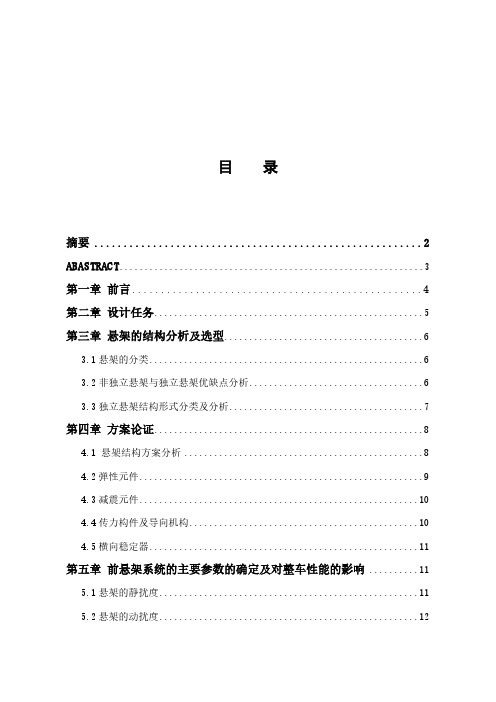
目录摘要 (2)ABASTRACT (3)第一章前言 (4)第二章设计任务 (5)第三章悬架的结构分析及选型 (6)3.1悬架的分类 (6)3.2非独立悬架与独立悬架优缺点分析 (6)3.3独立悬架结构形式分类及分析 (7)第四章方案论证 (8)4.1 悬架结构方案分析 (8)4.2弹性元件 (9)4.3减震元件 (10)4.4传力构件及导向机构 (10)4.5横向稳定器 (11)第五章前悬架系统的主要参数的确定及对整车性能的影响 (11)5.1悬架的静扰度 (11)5.2悬架的动扰度 (12)5.3悬架的弹性特性 (12)5.4前悬架主销侧倾角与后倾角 (13)第六章弹性元件的计算 (14)6.1 螺旋弹簧的设计 (14)第七章减震器机构的类型及主要参数的选择计算 (15)7.1减震器分类 (15)7.2相对阻尼系数 (15)7.3减震器阻尼系数的确定 (14)7.4最大卸荷力的确定 (17)7.5减震器工作缸直径的确定 (18)结论 (19)参考文献 (20)摘要为了提高汽车行驶的平顺性和稳定性, 本课题进行了产品名称为QF1020货车前后悬架的设计。
通过对课题内容的分析, 并结合相关设计手册,进行了方案设计与比较, 设计了麦弗逊前悬架, 钢板弹簧后悬架。
在设计中,首先,分析了麦弗逊独立悬架的组成和功用;其次,进行悬架的上各零部件强度的校核;第三,详细考虑各部件之间的连接关系;最后在此基础上进行悬架自然振动频率,悬架静挠度和动挠度以及悬架弹性特性的计算。
在分析麦弗逊悬架的组成和作用以及各零部件的尺寸确定的1基础上,再利用CAD软件进行二维制图。
此次的设计进行了准确的计算和详细的结构分析,为麦弗逊悬架的结构优化提供了依据,从而在运动学和动力学方面提高汽车的性能。
关键词:麦弗逊悬架;汽车;设计;ABSTRACT2In order to enhance the automobile smooth running and the stability, This topic has carried on the suspension design of the Product Name of QF1020 vehicle. Through analyzing the topic content, and combine the correlation design handbook, carried on the plan to design and to compare, the McPherson strut front suspension , the leaf spring behind suspension and trapezium’s frame are designed. This thesis first analyzes the consists and function of the McPherson suspension in the design, then check the up and down of the suspension, Third, the various components of the link between relations is considered the suspension on the basis of the natural vibration frequency is calculated as well as static suspension deflection and dynamic deflection and elastic characteristics of the suspension terms at last. On the basis of Analysis of the composition and role of the size of the components in the two suspension, then to use CAD software, 2D software mapping .We make an accurate and detailed structural analysis on the design, which provides the reference for optimal design of the suspension. The approach can enhance the performance of the McPherson suspension and leaf spring behind suspension.Keyword: McPherson suspension; Motor vehicle; Design;3第一章前言悬架是保证车轮或车桥与汽车承载系统(车架或承载式车身)之间具有弹性联系并能传递载荷、缓和冲击、衰减振动以及调节汽车行驶中的车身位置等有关装置的总称。
- 1、下载文档前请自行甄别文档内容的完整性,平台不提供额外的编辑、内容补充、找答案等附加服务。
- 2、"仅部分预览"的文档,不可在线预览部分如存在完整性等问题,可反馈申请退款(可完整预览的文档不适用该条件!)。
- 3、如文档侵犯您的权益,请联系客服反馈,我们会尽快为您处理(人工客服工作时间:9:00-18:30)。
┊┊┊┊┊┊┊┊┊┊┊┊┊装┊┊┊┊┊订┊┊┊┊┊线┊┊┊┊┊┊┊┊┊┊┊┊┊毕业设计(论文)客车悬架系统设计计算说明书院系:长安大学汽车学院指导教师:张平专业班级: 22010803学生姓名:杨文亮2012年6月18日┊┊┊┊┊┊┊┊┊┊┊┊┊装┊┊┊┊┊订┊┊┊┊┊线┊┊┊┊┊┊┊┊┊┊┊┊┊摘要目前我国的客车普遍采用的是传统钢板弹簧悬架,只有少数的高级客车才配置了空气悬架。
传统钢板弹簧的结构简单,成本较低。
而相对于传统机械钢板弹簧悬架而言,空气悬架具有乘坐更舒适、更好改善车辆的行驶平顺性等显著优点,但是造价也相对较高。
本文针对客车的悬架设计,在传统钢板弹簧悬架的基础上对前悬进行改进,前悬采用钢板弹簧与空气弹簧并联的混合式空气悬架,而后悬采用主副复合式钢板弹簧悬架。
前悬的混合式空气悬架能满足驾驶员舒适性的要求,而后悬架的主副复合式钢板弹簧降低了整车的生产成本。
对前、后悬架的主要零部件的尺寸进行设计计算,并运用CATIA进行建模和装配。
关键词混合式空气悬架,CATIA,主副复合式钢板弹簧悬架┊┊┊┊┊┊┊┊┊┊┊┊┊装┊┊┊┊┊订┊┊┊┊┊线┊┊┊┊┊┊┊┊┊┊┊┊┊ABSTRACTAt present, buses generally use the traditional leaf spring suspension in our country , only a handful of senior buses was equipped with air suspension. Traditional leaf spring structure is simple and with low cost . In contrastto traditional mechanical leaf spring suspension, the air suspension has more significant advantages, such as , more comfortable to ride, better improvement of the vehicle ride comfort. However , the cost is relatively high.This paper is about the bus suspension design .to improve the front suspension on the basis of the traditional leaf spring suspension , front suspension uses hybrid air suspension combined parallel with leaf springs andair springs , and then rear suspension uses primary and secondary compound leaf spring suspension. the front air suspension can meet the requirementsof driver comfort , but leaf spring in the rear suspension can reduce the manufacturing cost.Design and calculate the size parameters of the main components in the front and rear suspension, and modeling and assembly in use of CATIA.KEYWORDS: hybrid air suspension ,catia ,primary and secondary compound leafspring suspension┊┊┊┊┊┊┊┊┊┊┊┊┊装┊┊┊┊┊订┊┊┊┊┊线┊┊┊┊┊┊┊┊┊┊┊┊┊目录摘要 (II)ABSTRACT ......................................................................................................................... I II 第一章绪论 .. (1)1.1本课题研究的背景与意义 (1)1.2空气悬架技术发展概况 (2)1.2.1空气悬架发展历史 (2)1.2.2国外应用及技术研究状况 (3)1.2.3国内应用及技术研究状况 (4)1.3本课题研究的目的和内容 (5)目的: (5)内容: (5)第二章悬架概述及客车悬架方案的选定 (7)2.1 客车悬架的要求 (7)2.2方案确定 (7)2.3 空气悬架系统的特性 (8)2.4 悬架的分析 (8)2.5 混合式空气悬架 (9)2.6前悬架混合式空气弹簧设计 (11)2.6.1 设计依据 (11)2.6.2设计原则 (11)2.7 空气弹簧的结构 (11)2.8空气弹簧理论特性分析 (13)2.8.1空气弹簧的弹性特性 (13)2.8.2空气弹簧的负荷特性 (15)2.9 辅助机构设计 (17)2.9.1横向稳定装置 (17)2.9.2 横向稳定杆侧倾角刚度 (17)2.9.3横向稳定杆直径d (17)2.9.4缓冲块 (18)第三章后悬架复合式钢板弹簧设计 (19)3.1 钢板弹簧的布置方案 (19)┊┊┊┊┊┊┊┊┊┊┊┊┊装┊┊┊┊┊订┊┊┊┊┊线┊┊┊┊┊┊┊┊┊┊┊┊┊3.2 主副复合式钢板弹簧 (19)3.3设计依据 (19)3.4后悬架主、副弹簧刚度分配 (20)3.5钢板弹簧的静挠度 (20)3.6钢板弹簧的满载弧高 (21)3.7 钢板弹簧的断面形状 (21)3.8钢板弹簧主片长度的确定 (22)3.9钢板弹簧片厚的计算 (22)3.10 钢板弹簧片宽的计算 (23)3.11 钢板弹簧片数的计算 (24)3.12 钢板弹簧各片长度的计算 (24)3.13钢板弹簧刚度的计算 (25)3.14钢板弹簧总成在自由状态下的弧高及曲率半径的计算 (26)3.15 钢板弹簧的强度验算 (28)第四章减振器设计 (30)4.1相对阻尼系数ψ (30)4.2减振器阻尼系数δ的确定 (31)4.3最大卸荷力的确定 (31)4.4筒式减振器工作缸直径D的确定 (31)结论 (32)致谢 (33)参考文献 (34)┊┊┊┊┊┊┊┊┊┊┊┊┊装┊┊┊┊┊订┊┊┊┊┊线┊┊┊┊┊┊┊┊┊┊┊┊┊第一章绪论1.1本课题研究的背景与意义悬架是现代汽车上的重要组成之一,它把车架(或车身)与车轴(或车轮)弹性地连接起来。
其主要任务是传递作用在车轮和车架(或车身)之间的一切力和力矩;缓和路面传给车架(或车身)的冲击载荷,衰减由此引起的承载系统的振动,保证汽车的行驶平顺性;保证车轮在路面不平和载荷变化时有理想的运动特性,保证汽车的操纵稳定性,使汽车获得高速行驶能力。
目前,高级大客车和85%的重型货车都使用空气悬架,在国外,部分的轿车也开始使用空气悬架。
典型的大客车空气悬架主要是由空气弹簧组件(包括空气弹簧、空气压缩机、储气等)、高度控制组件(车身高度调节阀、高度传感器)、导向杆件(推力杆)、横向稳定器、减振器和缓冲限位部件等组成。
空气悬架系统是以空气弹簧为弹性元件,利用气体的可压缩性实现其弹性作用,并且容易实现悬架刚度的可控性。
通过压缩气体的气压能够随载荷和道路条件变化进行自动调节,不论满载还是空载,整车高度没有变化,可以大大提高乘坐的舒适性,空气悬架的研发己成为客车新技术研究的热点。
欧美等发达地区的高级客车几乎全部使用空气悬架,载货汽车上空气悬架的占有率为85%以上;2003年度我国大中型客车空气悬架的装备率为5%(约5000辆)。
到2010年,我国客车空气悬架的装备率将达到20%,以客车产量年增长速度10%计算,2010年度客车空气悬架的需求总量约为4万套,其年度市场总额将突破10亿元。
由于装备空气悬架的车辆具有舒适性、平顺性等方面的明显优势,对道路损坏减少50%,新国标规定装空气悬架的轴荷可增加15%,为此,我国载货汽车装备空气悬架的速度将飞速发展,预计到2010年其装备率将达到10%以上,年度市场总额超过50亿元。
近几年,空气悬架的需求主要是与高等级客车的销售量直接相关,2002年高级客车销售量为4000台左右,2003年突破6000台,据统计,高级客车的需求正以每年15%的速度快速增长。
国家汽车行业“十五规划”已经明确“重点发展适应高速公路需要的大中型客车,专用客车底盘及关键总成”,以及“根据市场需求适当发展高档旅游客车”的目标,同时预测,2005年大中型客车年需求量为12~16万辆(其中大型客车为3~5万辆,中型客车为9~11万辆)。
2002年7月,交通部颁布实施的《营运客车类型划分及等级评定》(JT/T325—2002)行业标准,明确规定了高级大中型客车必须采用空气悬架,这为空气悬架产品┊┊┊┊┊┊┊┊┊┊┊┊┊装┊┊┊┊┊订┊┊┊┊┊线┊┊┊┊┊┊┊┊┊┊┊┊┊的广泛应用创造了良好的条件和法规环境。
营运距离200km左右的中短途、以高速公路为营运路线、乘客人数30人左右、车长为7--10ra的高档中型客车在市场上尚属空缺,急需开发。
我国在空气悬架系统方面也做了大量研究,但主要集中在空气弹簧的特性和平顺性的仿真分析上,而且主要是针对大客车进行的。
因此,设计开发中型客车底盘空气息架系统,适应我国的道路状况和汽车行业的发展需要,填补国内空气悬架系统有市场、无技术的空白,极具现实意义!所以,研究客车底架及地板这一课题具有重大意义。
1.2空气悬架技术发展概况1.2.1空气悬架发展历史20世纪30年代初,美国凡世通轮胎公司首次把空气弹簧应用于汽车工业。
哈维·凡世通(Harvey Firestone)在亨利·福特一世(HcnlyFord I)和托马斯·阿瓦·爱迪生(Thomas Alva Edison)的技术支持下,在1934年研制出了空气柱形式的空气弹簧悬架系统——AIREDE空气弹簧。
1944年通用汽车公司与凡世通公司合作,在其客车上进行了首轮试验。
试验结果显示了空气悬架系统的内在优越性。
通用汽车公司经过大量的产品研制开发工作,1953年开始生产装有空气悬架的客车,这是商用汽车采用空气弹簧悬架的丌始。
20世纪50年代中叶,固特异轮胎公司研制出一种滚动凸轮式空气弹簧,凸轮在活塞的型面上滚动.从而控制空气弹簧的负载变形关系曲线。
